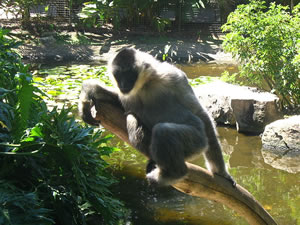Gibbons and orangutans use a means of locomotion known as brachiation, in which they use their arms to swing effortlessly from branch to branch of the tropical rainforest canopy.
Neither gibbons nor orangutans have tails to assist them with locomation.
Although both gibbons and orangutans will come down to the forest floor to search for insects and roots, they are more graceful and poised in the trees.
Gibbon
 Gibbons live in Southeast Asia, from Burma in the west to Borneo in the east. Males and females are about the same size and weigh 11 to 18 pounds (5 to 8kg).
Gibbons live in Southeast Asia, from Burma in the west to Borneo in the east. Males and females are about the same size and weigh 11 to 18 pounds (5 to 8kg).
They are distinguished by their dangling arms, which are about twice the length of the trunk. Their legs are 30 per cent longer than their trunks, making them relatively as long as a human being's
Elongated curved fingers make the gibbon's hands ideally suited to act as grappling hooks.
The gibbon's thumb is more deeply cleft than that of any other ape, including that of a human being. It is connected to the wrist bone with a ball and socket joint rather than a hinge. This allows the thumb a high degree of mobility, which is essential when the gibbon is racing through the trees.
The gibbon's rib cage is extremely solid; and the lumbar, or lower spine, is short and relatively inflexible. This prevents the trunk from becoming distorted during swinging movements.
Gibbons live in small troops that consist of a mated pair and up to four youngsters.
They defend their territories by shouting at others that come too close.
The most vocal gibbon is the Hoolock. Both males and females make warning calls, which sound like its name.
Within its territory, the troop searches for fruits, leaves, buds, flowers, eggs, insects and other small invertebrates.
Any large terrestrial animal will easily frighten the troop. However, large eagles are their only serious enemy. Large eagles will attack adults as well as young gibbons.
Orangutan
 The name orangutan means "man of the forest". Orangutans live in Borneo and Sumatra.
The name orangutan means "man of the forest". Orangutans live in Borneo and Sumatra.
They are much larger than gibbons.
Orangutans are about 5 feet (1.5m) tall. An old male may weigh up to 220 pounds (100kg), but females are almost half the size of males.
With an armspan of about 8 feet (2.4m), the orangutan can cover large distances quickly.
It sometimes crosses small gaps by launching itself from one branch to another and climbing and walking on branches as well as by brachiating.
Orangutan's thumbs are tiny, and play no part in gripping branches. Their fingers are strong and massive.
An orangutan will peel a small piece of fruit by holding it between its index and third finger while its teeth and lips work deftly at the peel.
Every night the orangutan builds a nest in the trees, breaking and bending branches and scattering leaves as bedding. Orangutans sleep in positions similar to those of humans, on their sides or backs, often with an open hand under the head.
The destruction of the rainforest for timber and agricultural has caused the orangutan to become endangered.